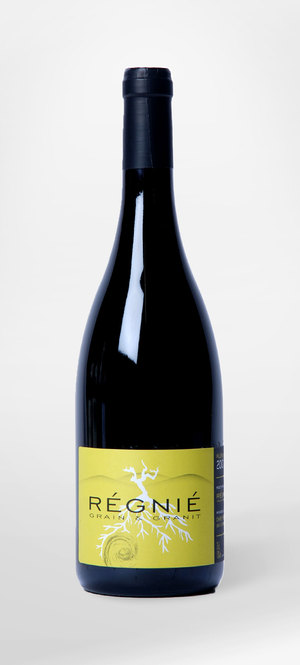Without doubt, I've developed adoration for Gamay and the wines it produces, particularly in the northern hills of Beaujolais.
I'm honest to say that I drank a lot of Beaujolais Nouveau when I was first started drinking wine. As my palate developed, I replaced the light, semi-bubbly, lollipop wine for more "mature" wines made from Pinot Noir, Syrah, and Nebbiolo. These grapes produce intense, complex wines that often take years to reach their optimum expression.
When the exceptional 2009 vintage of Beaujolais Crus were released, I was hypnotized by the amount of terroir these wines had in their youth, everything I love about Burgundy and Rhône mixed in one glass, at often a quarter of the price. I needed to get more, taste more, collect and learn more about these wines.
Gamay Noir à jus Blanc is the principle grape of Beaujolais Rouge AOP and the 10 Crus. The law also allows a max of 15% of Chardonnay, Aligoté, Melon de Bourgogne, Pinot Gris, Pinot Noir and the Gamay cousins, Gamay de Bouze and Gamay de Chaudenay in the blend.
Gamay has a long history in Burgundy, one of the first written mentions as “Gaamez” in the 14th century.
The grape was not always loved, in fact it was ordered to be “cut down wherever they grow in the country, within five months” by the Duc Philippe le Hardi in 1395. Known as Philip the Bold, he despised the aromas and flavors of this grape, perhaps because Gamay that grows on limestone and clay can be very tart, light and fruity. The soils of the Côte d’Or were not suitable for this grape and much more appropriate for Pinot Noir and Chardonnay.
He expelled it from his Duchy to further south in the region, which is now the department de Rhône. The granitic hills are much more suitable for high quality Gamay vineyards.
Gamay is a member of the Noirien ampelographic group, related close to Sacy, which is cultivated around Chablis, and is genetically proven to be a cross of Pinot and Gouais blanc, the parent grapes of many other “pinot” varieties, plus chardonnay, aligoté, auxerrois and romarantin. While the popular Gamay is of white flesh and clear juice, there exists a mutation called Gamay Teinturier Fréaux or Gamay Teinturier because of the red flesh and juice it produces.
Gamay in France is early budding and ripening, it is not very vigorous and therefore trained low to the ground in the Gobelet system or “bush vine”.
The grapes are hand harvested and usually undergo whole bunch fermentation by semi-carbonic maceration, which accumulates carbonic dioxide in the top of the vat and promote the grapes to burst when they begin to ferment. Carbon dioxide can also be pumped in a sealed vat, this reduces the presence of oxygen, yet will still allow the grape to convert some of it’s sugars into alcohol. The skins will release more color and aromas but are not associated with a long-lived or high quality wines.
Some producers can use the semi-carbonic technique and also mature the wines in new or used oak.
Gamay is a grape that can achieve an intense purple and electric blue color. Aromas of fresh, wild berries and purple flowers on young wines, with slight appearances of pepper and game. Several producers can be heavy on Brettanomyces, which is technically a fault in wine, but jokingly referred to as “terroir”. Aromas associated with“brett”are horse blanket, earth, barnyard.
The alcohol is moderate and acidity is always bright and elevated. Like Pinot Noir, Gamay has low tannins and is suitable for many cuisines. I especially enjoy a chilled Morgon with roasted chicken.
Cru Beaujolais producers I enjoy are mostly in Morgon: Foillard, Thévenet, Guy Breton, Marcel Lapierre, but also captured by Yvon Métras, Jules Desjourney, Château du Moulin-à-Vent and brand-new world wines from RPM (Roberts, Parr, Meyers) a collaboration from Rajat Parr and the guys from Arnot-Roberts.
Old vine Gamay in Morgon, Beaujolais
Worldwide, there are about 37,000 hectares of land contributed to growing Gamay grapes. The vast majority of this land is located in France, but the Gamay is grown in some smaller quantities in other regions and is highly adaptable
Other examples of Gamay-produced wines in France include Cheverny and Coteaux de Vendômois, Cotes du Forez, Saint-Pourçin and sparkling version in Bugey in Cerdon. In Switzerland, Gamay is the second most planted red grape and often blended to produce Dôle in the Valais. I’ve also had delicious Gamay in Niagara Peninsula and blended wines from Aosta in Northern Italy.
Some of our small producers in the United States have embraced Gamay and released a few in recent vintages. Evening Land makes a delicious Gamay in Oregon and the RPM is a solid textbook example of the style, grown on granitic hills in El Dorado, California.
Gamay is not just for Thanksgiving anymore, grab a slightly chilled bottle this summer and drink up with friends.








